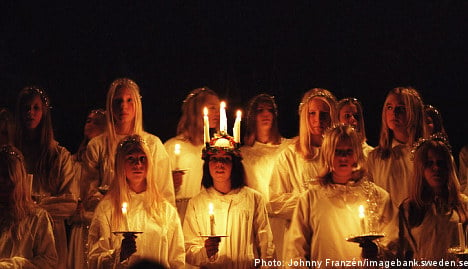By now it’s getting hard to share a seat on buses — the plump down jackets people use to keep out the cold increase personal volume considerably. The front corridor at the daycare centre is a mountain of children’s jump suits, and getting kids clothed and unclothed is an interminable operation. Christmas trees have been up in town squares for two weeks.
The Nobel ceremonies are held in Stockholm on the 10th. The daytime presentation from the hands of the monarch is followed by a gala banquet in the ornate City Hall. A live broadcast blends gossip and erudition, with comments on dresses and celebrity cleavage intermixed with pithy explanations of achievements in physics, medicine and economics. Alfred Nobel himself would enjoy the evening; he liked the good life in Paris and San Remo and the company of attractive women. But, painfully shy, he needed a topic of conversation and peace was his favourite. The City of San Remo, Italy, where Nobel spent his last years and where he died on 10 December 1896, sends truckloads of flowers each year for the ceremonies.
December is party time, often centred on the sticky, sweet mulled wine known as glögg and ginger biscuits. Glögg combines red wine, spirits and spices, taken in tiny glasses or cups into which you spoon raisins and blanched almonds. A little goes a long way. Glitter is optional, but ambitious hosts decorate the doorstep with fir branches.
December is also a month of lights, electric or otherwise. High-rise office windows display electric versions of the Advent candles. Big paper stars like Japanese lanterns hang in apartment windows. Private parties signal their location with thick candles in tins outside entrances. Light therapy challenges the demon darkness. The first word Swedish children learn is often lampa (lamp or light).
St. Lucia Day on the 13th replaces an ancient celebration of the winter solstice, when barnyard animals were said to be able to talk to each other and the long winter was halved. St. Lucia was believed to have lived in Sicily. Some say that when a saint saved Lucia’s sick mother from death, Lucia abandoned marriage plans and gave her dowry to the poor. Her fiancé took her to court and she was sentenced to a brothel but a thousand men, using oxen, could not drag her in. The modern custom involves angelic girl children dressed in white, although there is a role for Staffan the Stable boy, the comic relief. The white-robed children sing while lights dim and candles flicker. The custom came from nostalgic Swedish colonies in America a century ago and originally mandated a crown of lit candles in a blonde little sweetheart’s hair, predictably risk-filled in a milling crowd of excited kids.
Winter solstice on the 21st is when the country breathes a deep sigh of relief: finally, we can at least imagine light at the end of the tunnel! In Stockholm, office commuters might miss sun-up at about 8:30 am and certainly miss sundown at around 2:45 pm. They’re still lucky — up above the polar circle in the city of Kiruna, for example, it’s pitch black for about three weeks in mid-winter. Sweden is in the west-wind belt with chiefly southwesterly or westerly winds. The frigid winds of the Russian steppes seldom intrude.
Christmas and most other important holidays are celebrated on the eve. Christmas Day is for relaxing, except for whoever is preparing the smörgåsbord. The dishes are based on simple country fare — a way of gourmandizing while remaining down-to-earth. Staples include ham, pickled herring, jellied veal, boiled ling, beetroot and herring salad, and the essential meatballs, all washed down with snaps and sweet Christmas beer or a mixture of stout, port and lemonade. Then finish up with rice porridge. Phew!
Does bathwater run down the drain counterclockwise in the northern hemisphere and clockwise in the south? Fact: reindeer corralled in December will always run counterclockwise. Reindeer are also the only deer species where both males and females have horns. (Insert your own joke here about gender equality in Sweden.)
Come quarter to midnight on New Year’s Eve, the nation’s current favourite actor will be found breathing mist into the cold night air at a folklore heirloom, the outdoor museum at Skansen in Stockholm. As television lights flare, with the background a sky of pyrotechnical colour, the actor clears his throat. Then, as every year since the 1920s, the actor reads a poem written by the Englishman, Alfred Tennyson: “Ring out the old, ring in the new / Ring, happy bells, across the snow / The year is going, let him go / Ring out the false, ring in the true.” And ring in longer days.
The Year in Sweden by Kim Loughran is on sale now at the AdLibris online bookstore.


 Please whitelist us to continue reading.
Please whitelist us to continue reading.
Member comments